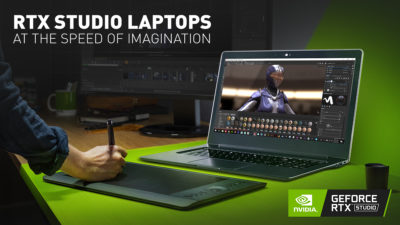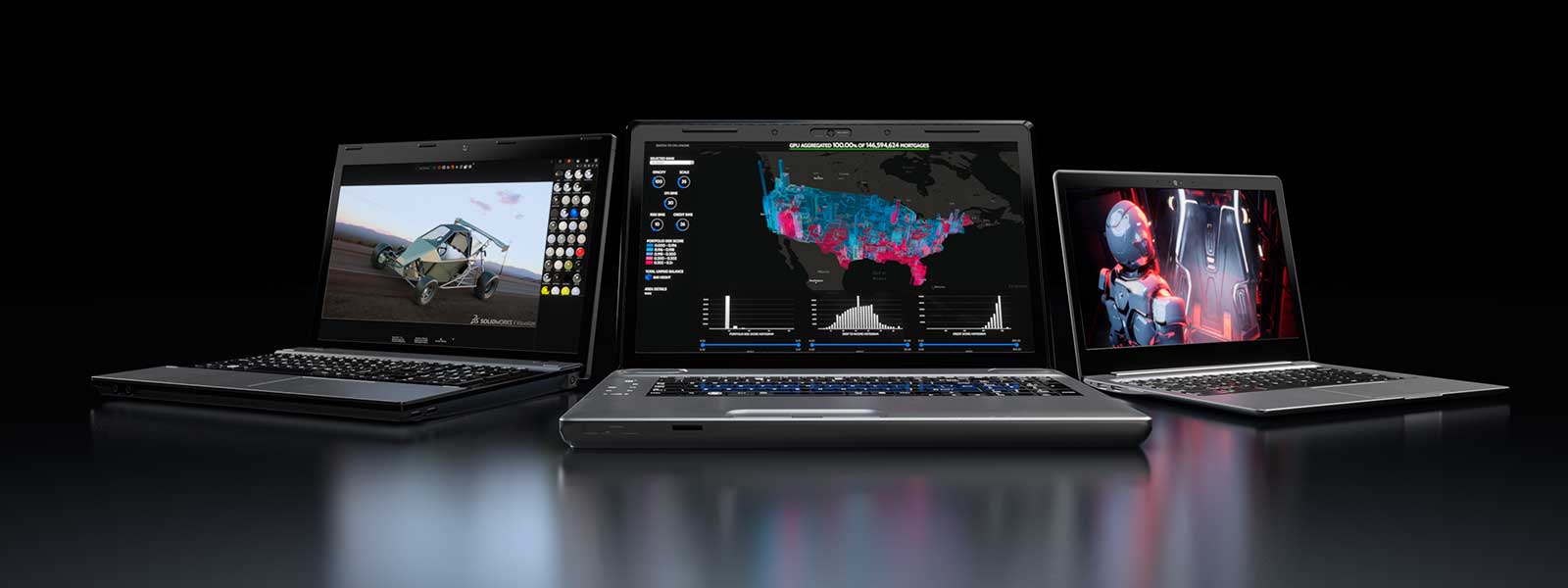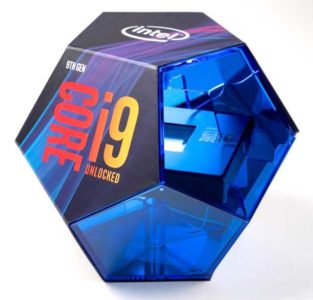A number of new technologies and products were just announced at this year’s Computex event in Taiwan. This focuses on the ones that seem relevant to media creation professionals.
 NVidia released a line of mobile workstation GPUs, based on their newest Turing architecture. Similar to the GeForce lineup, there are versions with and without the RTX designation. The Quadro RTX 5000, 4000, and 3000 have Ray Tracing and Tensor Cores, while the Quadro T2000 and T1000 do not, similar to the GeForce 16 products. The RTX 5000 matches the desktop version, with slightly more CUDA cores than than the GeForce RTX 2080, although at lower clockspeeds for reduced power consumption. The new Quadro RTX 3000 has similar core configuration to the desktop Quadro RTX 4000 and GeForce RTX 2070. This leaves the new Quadro RTX 4000 somewhere in between, with more cores than the desktop variant, aiming to provide similar overall performance at lower clockspeeds and power consumption. While I can respect the attempt to offer similar performance at given tiers, it does make it more complicated than just leaving consistent naming for particular core configurations.
NVidia released a line of mobile workstation GPUs, based on their newest Turing architecture. Similar to the GeForce lineup, there are versions with and without the RTX designation. The Quadro RTX 5000, 4000, and 3000 have Ray Tracing and Tensor Cores, while the Quadro T2000 and T1000 do not, similar to the GeForce 16 products. The RTX 5000 matches the desktop version, with slightly more CUDA cores than than the GeForce RTX 2080, although at lower clockspeeds for reduced power consumption. The new Quadro RTX 3000 has similar core configuration to the desktop Quadro RTX 4000 and GeForce RTX 2070. This leaves the new Quadro RTX 4000 somewhere in between, with more cores than the desktop variant, aiming to provide similar overall performance at lower clockspeeds and power consumption. While I can respect the attempt to offer similar performance at given tiers, it does make it more complicated than just leaving consistent naming for particular core configurations. NVidia also announced a new “RTX Studio” certification program for laptops targeted at content creators. They are designed to support content creation applications with “desktop-like” performance. RTX Studio laptops will include an RTX GPU (Either GeForce or Quadro), an H-Series or better Intel CPU, at least 16GB RAM and 512GB SSD, and at least a 1080p screen. Along with this they announced a new line of studio drivers that are supposed to work with both Quadro and GeForce hardware. They are optimized for content creators, tested for stability with applications from Adobe, Autodesk, Avid, and others. Hopefully these drivers will simplify certain external GPU configurations, mixing Quadro and GeForce hardware. It is unclear whether or not these new “Studio” drivers will replace the previously announced “Creator Ready” series of drivers.
NVidia also announced a new “RTX Studio” certification program for laptops targeted at content creators. They are designed to support content creation applications with “desktop-like” performance. RTX Studio laptops will include an RTX GPU (Either GeForce or Quadro), an H-Series or better Intel CPU, at least 16GB RAM and 512GB SSD, and at least a 1080p screen. Along with this they announced a new line of studio drivers that are supposed to work with both Quadro and GeForce hardware. They are optimized for content creators, tested for stability with applications from Adobe, Autodesk, Avid, and others. Hopefully these drivers will simplify certain external GPU configurations, mixing Quadro and GeForce hardware. It is unclear whether or not these new “Studio” drivers will replace the previously announced “Creator Ready” series of drivers.
 Intel announced a new variant of their top end 9900K CPU. The i9-9900KS has a similar configuration, but runs at higher clock speeds on more cores, with a 4Ghz base frequency, and allowing 5Ghz boost speeds on all 8 cores. They also offered more details on their upcoming 10nm Ice Lake products, with Gen11 integrated graphics offering numerous performance improvements, and VNNI support to accelerate AI processing. They are also integrating support for Thunderbolt3 and WiFi6 into the new chipsets, which should lead to wider support for those interfaces. The first 10nm products to be released will be the low power chip for tablets and ultra portable laptops, with higher power variants coming further in the future.
Intel announced a new variant of their top end 9900K CPU. The i9-9900KS has a similar configuration, but runs at higher clock speeds on more cores, with a 4Ghz base frequency, and allowing 5Ghz boost speeds on all 8 cores. They also offered more details on their upcoming 10nm Ice Lake products, with Gen11 integrated graphics offering numerous performance improvements, and VNNI support to accelerate AI processing. They are also integrating support for Thunderbolt3 and WiFi6 into the new chipsets, which should lead to wider support for those interfaces. The first 10nm products to be released will be the low power chip for tablets and ultra portable laptops, with higher power variants coming further in the future.
 AMD took the opportunity to release new generations of both CPUs and GPUs. On the CPU front, they have a number of new 3rd generation 7nm Ryzen processors, with 6-12 cores, in the 4Ghz range, supporting 20 lanes of 4th gen PCIe. Priced between $200 and $500, they are targeted at consumers and gamers, and are slated to be available July 7th. (7/7 for 7nm products) These compete with Intel’s 9900K and similar CPUs, which have been offering top performance for Premiere and After Effects users, due to their high clock speed. It will be interesting to see if AMD’s new products offer competitive performance at that price point.
AMD took the opportunity to release new generations of both CPUs and GPUs. On the CPU front, they have a number of new 3rd generation 7nm Ryzen processors, with 6-12 cores, in the 4Ghz range, supporting 20 lanes of 4th gen PCIe. Priced between $200 and $500, they are targeted at consumers and gamers, and are slated to be available July 7th. (7/7 for 7nm products) These compete with Intel’s 9900K and similar CPUs, which have been offering top performance for Premiere and After Effects users, due to their high clock speed. It will be interesting to see if AMD’s new products offer competitive performance at that price point.
 AMD also finally publicly released their Navi generation GPU architecture, in the form of the new Radeon 5700. The 5000 series has an entirely new core design, which they call Radeon DNA (RDNA) to replace the GCN architecture first released 7 years ago. RDNA is supposed to offer 25% more performance per clock cycle, and 50% more performance per watt. This is important, because power consumption has their weak point, compared to competing products from NVidia. While GPU power consumption isn’t as big of a deal for gamers using it a couple hours a day, commercial compute tasks that run 24/7 see significant increases in operating costs for electricity and cooling when power consumption is higher. AMD’s newest Radeon 5700 is advertised to compete performance-wise with the GeForce RTX 2070, meaning that NVidia still holds the overall performance crown for the foreseeable future. But the new competition should drive down prices in the mid-range performance segment, which are the cards most video editors need.
AMD also finally publicly released their Navi generation GPU architecture, in the form of the new Radeon 5700. The 5000 series has an entirely new core design, which they call Radeon DNA (RDNA) to replace the GCN architecture first released 7 years ago. RDNA is supposed to offer 25% more performance per clock cycle, and 50% more performance per watt. This is important, because power consumption has their weak point, compared to competing products from NVidia. While GPU power consumption isn’t as big of a deal for gamers using it a couple hours a day, commercial compute tasks that run 24/7 see significant increases in operating costs for electricity and cooling when power consumption is higher. AMD’s newest Radeon 5700 is advertised to compete performance-wise with the GeForce RTX 2070, meaning that NVidia still holds the overall performance crown for the foreseeable future. But the new competition should drive down prices in the mid-range performance segment, which are the cards most video editors need.

